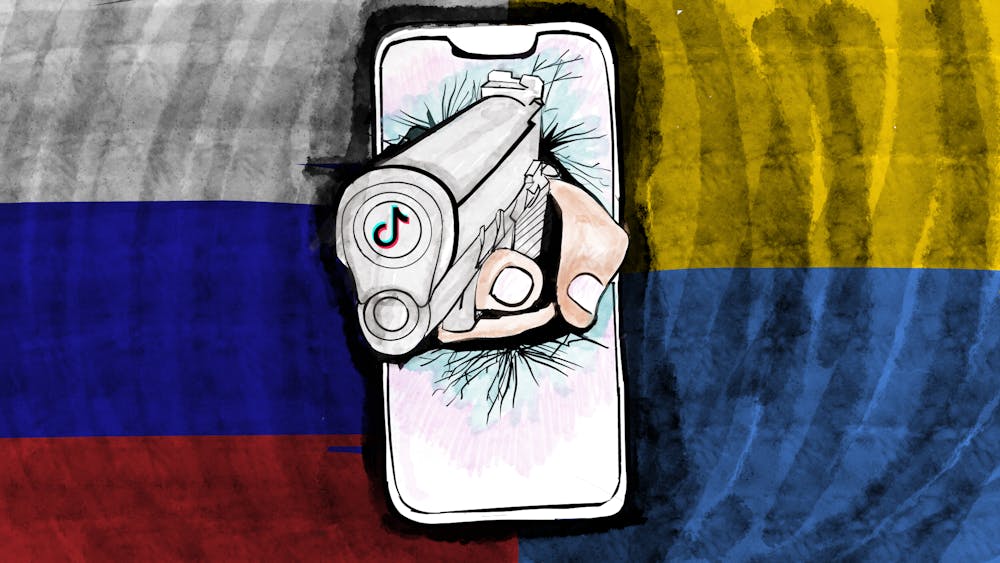Sirens blaring, helpless citizens huddled in blankets, missiles shooting across the sky, cities ripped apart. These are just some of the horrifying things I can expect to see and hear daily when scrolling through my TikTok “For You” page—and these TikTok videos speak to me in ways that other forms of media don’t.
On Feb. 24, 2022, Russia launched a full–scale invasion of Ukraine. Due to the widespread use of TikTok in order to share information about the war, it’s being called “the first TikTok war.” New York Magazine dubbed it “WarTok.”
Although there are many young adults documenting the war on TikTok, one in particular pops up in my feed daily. Her name is Valeria Shashenok, and she is a 20–year–old photographer from Chernihiv, Ukraine. Right up until Feb. 24, Valeria’s TikTok profile was full of breathtaking shots of her traveling all over the world—from Italy to Portugal—taking photographs and enjoying her early 20s with friends and family.
Her content changed drastically after the invasion began, and she started creating videos which gave her viewers an inside look into her new reality of living in a bomb shelter with her family. She has now amassed over 950,000 followers on TikTok. Her most viewed video has an astounding 43.5 million views, and details her “typical day in a bomb shelter.”
Valeria incorporates humor into many of her videos, which allows viewers to empathize with and relate to her. She also makes use of popular TikTok trends, songs, filters, and dances, thus "[speaking] to TikTok users in their own language" all over the world and boosting her content in the algorithm. In one video, she gives viewers a tour of the bomb shelter she lives in with the sarcastic caption “Welcome to my 5 stars hotel.” She then highlights the not–so–glamorous way of life, including showing herself sitting on the toilet and explaining that it is her “Place for reading books!”
Aside from her ironic content, Valeria also gives viewers a glimpse into her war–torn city during brief outings from the bomb shelter each day. Rubble, collapsed buildings, shattered windows, and abandoned homes are all around her. One particularly upsetting video includes footage she captured during the seventh day of the war, on March 3. She shows her friend’s house which has been bombed, and while standing outside of the destroyed building, she says, “I never can’t imagine how people felt in the Second World War. … Now I’m living in this reality and feel scared of my life. … Please, Putin, stop!”
In an interview with The Cut, Valeria expresses that people watching her videos need to know that “Ukrainian people are the strongest.” This is evident in her own videos as her strength shines through. Despite being so young, she’s doing incredible work to open up people’s eyes all over the world.
While WarTok may seem unique due to the fact that it leverages TikTok as a platform to share information about the Russia–Ukraine war, it’s important to keep in mind that different forms of media have played a revolutionary role in disseminating information about many wars throughout history. For instance, the Vietnam War was dubbed the “first television war.” Emerging technologies have been used time and time again to document wars, and, given the fact that TikTok was ranked the most popular website in 2021, it’s not surprising that it’s the platform of choice at this moment in history.
The White House held a briefing where “30 top TikTok stars gathered on a Zoom call to receive key information about the war unfolding in Ukraine.” TikTok influencers hold a lot of power because millions of people consume their content daily. The importance of educating them on the crisis so that they can share correct information with their followers is an important step given that TikTok has become such a widely trusted source of information.
The fact that TikTokers in Ukraine can show the world what's happening in real time heightens the sense of immediacy felt by viewers and gets people talking. This is a good thing, but there are some potential downsides when it comes to watching the same people repeatedly. There's the potential for viewers to see what Valeria goes through, for example, and think that it's the whole story even though it's just one person’s experience. Just because we follow her story doesn’t mean that we know every story, and just because she's safe now—having fled to Poland recently—doesn’t mean everyone is. It's crucial to keep this in mind.
Putin has already taken extreme measures to censor Russian media, banning Facebook, Twitter, and Instagram, and TikTok has now banned Russian users from posting and viewing international content—only “pro–Putin” content is allowed. All of this comes after Putin enacted the “fake news” law, which makes it a punishable offense to post anything challenging Russia’s invasion of Ukraine, as an attempt by Russia to try and “control the narrative over its invasion of Ukraine.”
Many TikTokers like Valeria have shared that they post videos of their experiences to try to “combat misinformation in the Russian news that the country’s actions were a ‘military operation’ rather than a war that is hurting Ukrainians.” Even though Russia’s intense censorship makes that particular goal difficult, people in countries across the globe are still able to see the truth thanks in large part to TikTokers like Valeria, and that's extraordinarily meaningful.







